How did the war in Korea begin, still ongoing
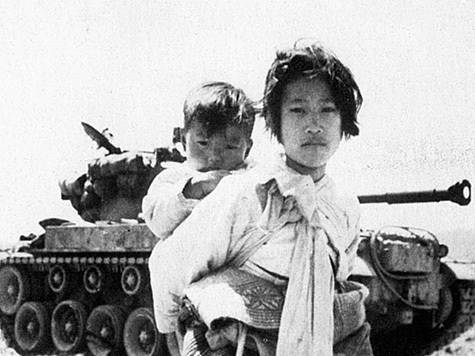
The largest military incident between North Korea and the Republic of Korea over the past half century recalled that the war on the Korean Peninsula has not yet been completed. The truce signed in 1953, stopped the armed struggle only in fact. Without a peace treaty, the two Koreas are still in a state of war. "MK" asked to tell about the causes and consequences of the Korean War one of the largest Russian experts on Korea.
“The main reason for the Korean War is the internal situation on the peninsula,” says Konstantin ASMOLOV, leading researcher at the Institute of the Far East of the Russian Academy of Sciences. - The Soviet-American contradiction only aggravated the conflict, which already existed, but did not initiate it. The fact is that Korea, one might say, was cut alive - this is the same as drawing a line in Russia at the Bologoye latitude and saying that now there is Northern Russia with its capital in St. Petersburg and South with its capital in Moscow. It is clear that such an unnatural state of affairs caused both Pyongyang and Seoul a keen desire to unite Korea under their authority.
- What were the two Koreas before the start of the war?
The modern audience often imagines the beginning of a conflict as a sudden and unprovoked attack of the North on the South. This is not true. South Korean President Lee Seung Man, despite the fact that he lived in America for a long time, which made him speak English better than his native Korean, was by no means an American puppet. The elderly Lee seriously considered himself a new messiah of the Korean people, and was so eager to fight that the US was afraid to supply offensive weapons to it, fearing that it would drag the American army into a completely unnecessary conflict.
The regime did not use the support of the people. The left, anti-lisynman movement was very strong. In 1948, a whole infantry regiment rebelled, the insurgency was hardly suppressed, and Jeju Island for a long time was seized by a communist uprising, during the suppression of which almost every fourth inhabitant of the island died. However, the left movement in the South was very little connected even with Pyongyang, and even more so with Moscow and the Comintern, although the Americans were firmly convinced that any manifestation of the left, where communist or close to them slogans are put forward, is conducted by Moscow.
Because of this, throughout the 49th year and the first half of the 50s, the situation on the border was reminiscent of trench wars of the First World War, where incidents involving the use of almost every day aviation, artillery and military units up to the battalion, and southerners more often acted as the attacking side. Therefore, some historians in the West even distinguish this period as a preliminary or partisan stage of the war, noting that on June 25, 1950, the conflict simply changed its scale.
It is necessary to note something important with respect to the North. The fact is that when we talk about the leadership of the DPRK of that time, we are projecting stamps of late North Korea on it, when there was no one except the great leader Comrade Kim Il Sung. But then everything was different, there were different factions in the ruling party, and if the DPRK resembled the Soviet Union, it was rather the USSR 20s, when Stalin was not yet a leader, but only the first among equals, and Trotsky, Bukharin or Kamenev remained significant and authoritative figures. This is certainly a very rough comparison, but it is important for understanding that Comrade Kim Il Sung was not the Kim Il Sung whom we used to know, and there were also influential people in the leadership of the country, whose role in preparing the war was no less if not more.
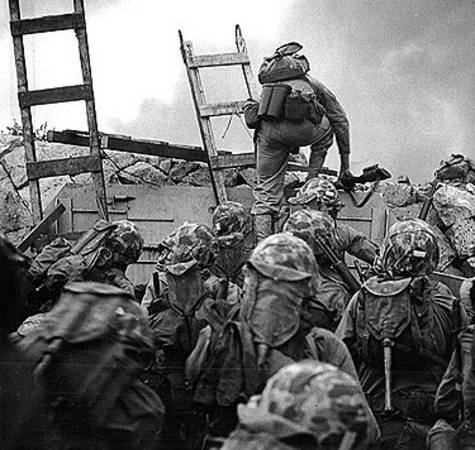
The landing of US forces in Incheon
The main "lobbyist" of the war from the DPRK was the head of the "faction of local communists" Pak Hon Yong, who was the second person in the country - the foreign minister, first deputy prime minister and first head of the communist party, which was formed in Korea immediately after liberation from the Japanese, while Kim Il Sung was still in the USSR. However, until 1945, Puck also managed to work in the Comintern structures, he lived in the Soviet Union in 20-30 and had influential friends there.
Pak insisted that as soon as the DPRK army crossed the border, the 200 of thousands of South Korean communists would immediately fight, and the regime of American puppets would fall. It should be remembered that the Soviet bloc did not have an independent agent who could verify this information, so all decisions were made on the basis of the information provided by Pak.
Until a certain time, both Moscow and Washington did not give the Korean leaders carte blanche for a “unification war”, although Kim Il Sung desperately bombarded Moscow and Beijing with requests to allow an invasion of the South. Moreover, the 24 of September of 1949 of the Political Bureau of the Central Committee of the CPSU (b) assessed the plan of launching a preemptive strike and the liberation of the South as inexpedient. The open text indicated that “an unprepared properly offensive could turn into protracted military operations that not only did not lead to the defeat of the enemy, but also create significant political and economic difficulties.” However, in the spring of 1950, permission was nevertheless obtained.
- Why did Moscow change the decision?
- It is believed that the case was in the appearance in October 1949 of the People’s Republic of China as an independent public entity, but the PRC had just emerged from a protracted civil war, and there were problems there. Rather, at some stage Moscow was nevertheless convinced that the situation in South Korea is revolutionary, the war will pass like a blitzkrieg, and the Americans will not intervene.
This we now know that the United States took more than an active part in this conflict, but at that time such a development was by no means obvious. Everyone was more or less aware that in the American administration, Li Seung Man was disliked. He had good connections with some military and Republican figures, but the Democrats didn’t like him very much, and in the CIA reports, Li Seung Man’s was openly called the old marazmatik. He was a suitcase without a handle, which is very heavy and uncomfortable to carry, but which can not be thrown. The defeat of the Kuomintang in China played its role - the Americans did nothing to defend their ally Chiang Kai-shek, and the United States needed him much more than some kind of Lee Seung Man. The conclusion was that if the Americans did not support Taiwan and only announced its passive support, then certainly they would not defend South Korea.
The fact that Korea was officially removed from the defense perimeter of those countries that America had promised to protect, was also easy to interpret as a sign of America’s future non-interference in Korean affairs because of its insufficient importance.
Moreover, the situation at the beginning of the war was already tense, and on the world map one could find many places where the “communist threat” could escalate into a serious military invasion. West Berlin, where there was a very serious crisis in 1949, Greece, where a three-year civil war between communists and royalists had just ended, the confrontation in Turkey or Iran - all this was seen much more hot spots than some Korea.
It is another matter that after the invasion began, the State Department and the administration of President Truman found themselves in a situation where this time it was no longer possible to retreat, whether you like it or not, you will have to get involved. Truman believed in the doctrine of the containment of communism, paid very serious attention to the UN and thought that if we again allow slack here, the Communists would believe in their impunity and immediately begin to put pressure on all fronts, and this must be strictly fixed. In addition, McCarthyism was already raising its head in the United States, and this meant that the officials had not to be considered “rosy”.
Of course, one can guess whether Moscow’s decision would support Pyongyang if the Kremlin knew for certain that the masses of the South would not support the invasion, and the US administration would take it as an open challenge, which it would certainly have to confront. Perhaps events would have developed differently, although tensions would not go away, and Lee Seung Man would also actively try to get approval for aggression from the US. But the subjunctive mood storyas you know, does not know.
* * *
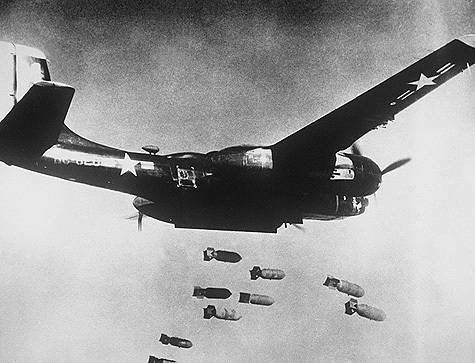
B-26 bomber drops bombs
- 25 June 1950, the North Korean troops crossed the border, and the first phase of the war began, in which the North Koreans divided the corrupt and poorly trained South Korean army, like God the tortoise. Seoul was taken almost immediately, on June 28, and when the DPRK troops were already approaching the city, South Korean radio was still broadcasting reports that the army of the Korean Republic had repelled the communist attack and was victoriously moving to Pyongyang.
Having seized the capital, the northerners waited a week for when the uprising would begin. But it did not happen, and the war had to continue amid the ever-increasing involvement of the United States and its allies in the conflict. Immediately after the start of the war, the United States initiated the convocation of the UN Security Council, which mandated the use of international forces to "expel the aggressor" and entrusted the leadership of the "police action" to the United States led by General D. MacArthur. The USSR, whose representative boycotted the meetings of the Security Council because of the participation of the representative of Taiwan in it, was unable to impose a veto. So the civil war turned into an international conflict.
As for Pak Hong Yong, when it became clear that there would be no rebellion, he began to lose influence and status and towards the end of the war, Pak and his grouping were eliminated. Formally, he was declared a conspiracy and espionage in favor of the United States, but the main accusation was that he “set up” Kim Il Sung and dragged the country's leadership into the war.
At first, success was still favored by the DPRK, and at the end of July 1950, the Americans and South Koreans retreated to the southeast of the Korean Peninsula, organizing the defense of the so-called Busan perimeter. The training of North Korean soldiers was high, and even the Americans could not resist the T-34 - their first clash ended in Tanks just drove through the fortified line that they had to hold.
But the North Korean army was not prepared for a long war, and the commander of the American troops, General Walker, with the help of quite tough measures, managed to stop the North Korean advance. The offensive was exhausted, the communication lines were stretched, the reserves were exhausted, most of the tanks were still disabled, and in the end the attackers turned out to be less than those who are defending themselves inside the perimeter. Add to this that the Americans almost always had full air supremacy.
In order to achieve a breakthrough in the course of military operations, the commander of the "UN troops", General D. MacArthur, developed a very risky and dangerous plan for an amphibious operation in Inchon, on the west coast of the Korean Peninsula. His colleagues believed that such a landing was a task close to impossible, but MacArthur struck the matter on his charisma, and not on intellectual arguments. He had a sort of flair that sometimes worked.
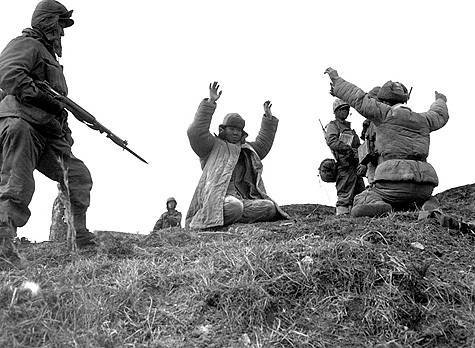
US Marine Corps Takes Chinese Soldiers
Early in the morning of September 15, the Americans landed near Incheon and, after fierce battles of September 28, seized Seoul. Thus began the second phase of the war. By early October, the northerners left the territory of South Korea. Here the United States and its South Korean allies decided not to miss the chance.
October 1 UN troops crossed the demarcation line, and by October 24 occupied most of the North Korean territory, reaching the Yalu River (Amnokkan) bordering China. What happened in the summer months with the South has now happened to the North.
But here, China, which had warned more than once that it would intervene if UN troops cut off the 38 parallel, decided to act. Giving the US or the pro-American regime access to the Chinese border in the northeast region could not be allowed. Beijing sent troops to Korea, which were formally called the "Army of Chinese People's Volunteers (DTBB)" under the leadership of one of the best Chinese commanders, General Peng Dehuai.
There were many warnings, but General MacArthur did not pay attention to them. In general, by this time he considered himself a kind of relative prince who knows better than Washington what to do in the Far East. In Taiwan, he was met according to the protocol of the meeting of the head of state, and he openly ignored a number of instructions from Truman. Moreover, during a meeting with the president, he openly declared that the PRC would not dare to join the conflict, and if he dared, the US Army would arrange for them a “great slaughter”.
October 19 1950 g. DDC crossed the Sino-Korean border. Taking advantage of the surprise effect, on October 25, the army crushed the defenses of the UN troops, and by the end of the year, the northerners regained control over the entire territory of North Korea.
The onset of the Chinese volunteers marked the third stage of the war. Somewhere the Americans simply fled, somewhere they were adequately retreating, making their way through Chinese ambushes, so that by the beginning of winter the position of the South and the UN troops was very unenviable. 4 January 1951 DPRK troops and Chinese volunteers again occupied Seoul.
By January 24, the advance of Chinese and North Korean troops had slowed down. General M. Ridgeway, who replaced the deceased Walker, managed to stop the Chinese offensive with a meat grinder strategy: the Americans are fixed at the commanding heights, waiting for the Chinese to capture everything else and launch aviation and artillery, opposing their advantage in firepower to the Chinese number.
Since the end of January, 1951, the American command launched a series of successful operations, and thanks to the counteroffensive, in March, Seoul again passed into the hands of southerners. Even before the completion of the counter-attack, April 11 due to disagreements with Truman (including on the idea of using nuclear weapon), D. MacArthur was removed from the post of commander of the UN forces and replaced by M. Ridgeway.
In April - July, 1951. The belligerents made a number of attempts to break through the front line and change the situation in their favor, but none of the parties reached a strategic advantage, and military actions acquired a positional character.
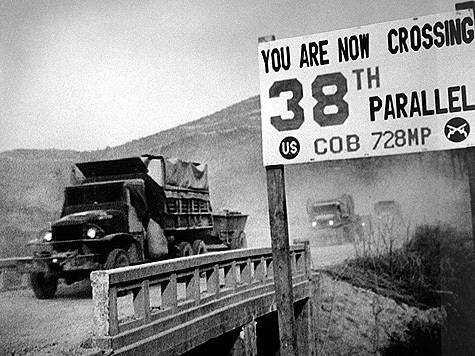
UN forces cross 38 parallel, retreating from Pyongyang
By this time, it became clear to the parties to the conflict that it was impossible to achieve a military victory at a reasonable price and negotiations for an armistice were necessary. 23 June, the Soviet representative to the UN called for a cease-fire in Korea. 27 November 1951 parties agreed to establish a demarcation line on the basis of the existing front line and create a demilitarized zone, but then the negotiations came to a standstill, mainly because of the position of Lee Seung Man, who categorically advocated the continuation of the war, as well as disagreements over the repatriation of prisoners of war.
The problem with the prisoners was as follows. Usually after the war, prisoners change according to the principle of “all for all”. But during the war, in the absence of human resources, the North Koreans actively mobilized the people of the Republic of Korea who did not particularly want to fight for the North and surrendered as soon as possible. The situation was similar in China; there were quite a few soldiers from former Kuomintang prisoners captured during the civil war. As a result, about half of the captured Koreans and Chinese refused to repatriate. The settlement of this issue took the most time. And Lee Seung Man almost broke the sentences, simply ordering the camp guards to release those who do not want to return. In general, by this time the South Korean president had become so annoying that the CIA even developed a plan to remove Lee Seung Man from power.
27 July 1953 representatives of the DPRK, the CNDA and the UN troops (representatives of South Korea refused to sign the document), signed a cease-fire agreement, according to which the demarcation line between North and South Korea was established along the 38 parallel, and on both sides around it formed demilitarized zone width 4 km.
- You talked about American air superiority, it is unlikely that Soviet veterans would agree with that.
- I think they will agree, because our pilots had a very limited set of tasks related to the fact that the Americans used strategic bombardments in principle of peaceful objects, for example, dams and hydropower plants, as an additional lever of influence on the North. Including those who were in the border areas. For example, the Supkhun hydroelectric station, depicted on the DPRK's coat of arms and the largest power station in the region, supplied not only Korea but also northeastern China with electricity.
So, the main work of our fighters was precisely to protect industrial facilities on the border of Korea and China from the attacks of American aviation. They did not fight on the front lines and did not take part in offensive operations.
As for the question "who is whom", then each side is sure that she won the victory in the air. The Americans naturally consider all the MIGs that they shot down, but not only ours, but also the Chinese and Korean pilots, whose flying skills left much to be desired, flew the MIGs. In addition, the main purpose of our MIGs was the “flying fortresses” B-29, while the Americans were hunting for our pilots, trying to protect their bombers.
- What is the result of the war?
- The war left a very painful scar on the body of the peninsula. Can imagine the extent of destruction in Korea, when the front line was swinging like a pendulum. Incidentally, more napalm was dropped on Korea than on Vietnam, and this despite the fact that the Vietnam War was almost three times longer. The dry residue of losses is as follows: that the losses of the troops on both sides amounted to approximately 2 million 400 thousand people. Together with civilians, although it is very difficult to take into account the total number of killed and wounded civilians, it turns out about 3 million people (1.3 million southerners and 1.5-2.0 million northerners), which made up 10% of the population of both Koreas during this period. Another 5 million people became refugees, although the period of active hostilities took only a little over a year.
From the point of view of achieving their goals, no one won the war. Unification was not achieved, the Demarcation Line, which quickly turned into a “Great Korean Wall,” was created, only emphasized the split of the peninsula, and in the minds of several generations who survived the war, there was a psychological attitude to confrontation - a wall of hostility and mistrust grew between the two parts of one nation. Political and ideological confrontation was only consolidated.
- http://www.mk.ru"rel =" nofollow ">http://www.mk.ru
Information